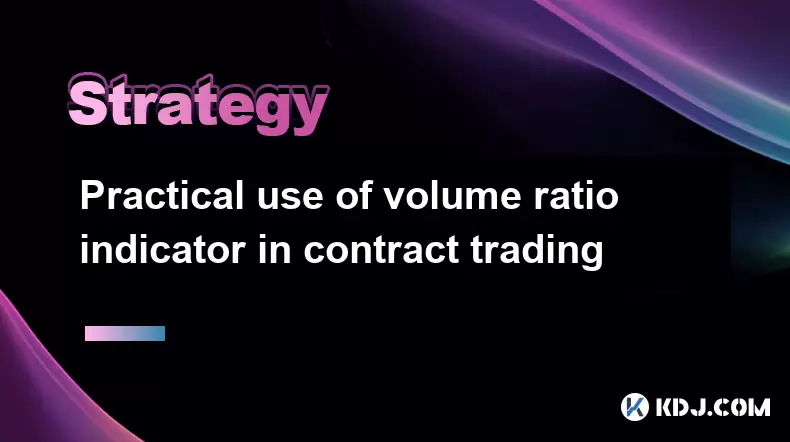-
 bitcoin
bitcoin $122090.672462 USD
1.59% -
 ethereum
ethereum $4493.758974 USD
0.56% -
 xrp
xrp $3.033145 USD
0.65% -
 tether
tether $1.000629 USD
0.00% -
 bnb
bnb $1169.854250 USD
7.07% -
 solana
solana $230.954786 USD
-0.19% -
 usd-coin
usd-coin $0.999785 USD
0.00% -
 dogecoin
dogecoin $0.256108 USD
-1.12% -
 tron
tron $0.342333 USD
-0.12% -
 cardano
cardano $0.859632 USD
-0.10% -
 hyperliquid
hyperliquid $48.932146 USD
-2.25% -
 chainlink
chainlink $22.345466 USD
-1.29% -
 ethena-usde
ethena-usde $1.000217 USD
-0.03% -
 avalanche
avalanche $31.203456 USD
1.93% -
 sui
sui $3.579145 USD
1.05%
Practical use of volume ratio indicator in contract trading
The volume ratio indicator helps traders analyze cryptocurrency market trends by comparing current trading volume to a moving average, aiding in strategic trading decisions.
Jun 02, 2025 at 01:22 am

The volume ratio indicator is a powerful tool used by traders in the cryptocurrency market to analyze the strength and direction of price movements. In contract trading, understanding how to effectively use the volume ratio indicator can significantly enhance your trading strategy. This article will delve into the practical applications of the volume ratio indicator, helping you to make more informed decisions in your trading activities.
Understanding the Volume Ratio Indicator
The volume ratio indicator is a technical analysis tool that compares the current trading volume to a moving average of volume over a specific period. It is typically displayed as a line chart that oscillates around a central value, often set at 1. A reading above 1 indicates that the current volume is higher than the average volume, suggesting increased market activity and potential price movement. Conversely, a reading below 1 suggests lower than average volume, which may indicate a lack of market interest or a potential consolidation phase.
To use the volume ratio indicator effectively, traders must first understand how to interpret its signals. A rising volume ratio can signal that a trend is gaining strength, as more traders are participating in the market. On the other hand, a falling volume ratio might indicate that a trend is losing momentum, as fewer traders are actively trading.
Setting Up the Volume Ratio Indicator
Setting up the volume ratio indicator on your trading platform is a straightforward process. Here’s how you can do it:
- Open your trading platform: Ensure that you are using a platform that supports the volume ratio indicator, such as TradingView or MetaTrader.
- Navigate to the indicators section: Look for the indicators or studies section in your platform’s menu.
- Search for the volume ratio indicator: Type “volume ratio” in the search bar to find the indicator.
- Add the indicator to your chart: Once you find the volume ratio indicator, click on it to add it to your chart.
- Adjust the settings: You can customize the period over which the moving average is calculated. A common setting is a 20-day moving average, but you can adjust this based on your trading strategy.
Using the Volume Ratio Indicator in Trend Analysis
One of the primary uses of the volume ratio indicator in contract trading is to confirm the strength of a trend. When the price of a cryptocurrency is moving in a particular direction, the volume ratio indicator can help you determine whether the trend is likely to continue or reverse.
- Confirming an uptrend: If the price of a cryptocurrency is rising and the volume ratio indicator is also increasing, this suggests that the uptrend is strong and likely to continue. Traders might consider entering long positions or adding to existing positions in this scenario.
- Confirming a downtrend: Conversely, if the price is falling and the volume ratio indicator is also decreasing, this indicates that the downtrend is robust and may persist. Traders might consider entering short positions or increasing their short exposure.
- Identifying potential reversals: If the price is moving in one direction but the volume ratio indicator is moving in the opposite direction, this could signal a potential trend reversal. For example, if the price is rising but the volume ratio is falling, it may suggest that the uptrend is losing steam and a reversal could be imminent.
Volume Ratio Indicator in Breakout Trading
Breakout trading is another area where the volume ratio indicator can be particularly useful. A breakout occurs when the price of a cryptocurrency moves above or below a significant level of support or resistance. The volume ratio indicator can help traders identify whether a breakout is likely to be sustainable.
- Confirming a breakout: If the price breaks above a resistance level and the volume ratio indicator is also rising, this suggests that the breakout is supported by strong volume and is more likely to continue. Traders might consider entering long positions after such a confirmed breakout.
- Identifying false breakouts: If the price breaks a level but the volume ratio indicator does not show a corresponding increase, this could indicate a false breakout. In such cases, the price might quickly reverse back to the previous range. Traders should be cautious and may want to wait for additional confirmation before entering a position.
Volume Ratio Indicator and Divergence
Divergence occurs when the price of a cryptocurrency and the volume ratio indicator move in opposite directions. This can be a powerful signal for traders to anticipate potential reversals or trend continuations.
- Bullish divergence: If the price of a cryptocurrency is making lower lows, but the volume ratio indicator is making higher lows, this suggests a bullish divergence. It indicates that the selling pressure is weakening, and a potential reversal to the upside could be imminent.
- Bearish divergence: Conversely, if the price is making higher highs, but the volume ratio indicator is making lower highs, this suggests a bearish divergence. It indicates that the buying pressure is waning, and a potential reversal to the downside could be on the horizon.
Integrating the Volume Ratio Indicator with Other Tools
While the volume ratio indicator is a valuable tool on its own, it is most effective when used in conjunction with other technical analysis tools. Here are some ways to integrate the volume ratio indicator with other indicators:
- Moving averages: Combining the volume ratio indicator with moving averages can help traders identify trend directions and potential entry and exit points. For example, if the price is above a moving average and the volume ratio indicator is rising, this can confirm a bullish trend.
- Relative Strength Index (RSI): The RSI measures the speed and change of price movements. When used with the volume ratio indicator, it can help traders identify overbought or oversold conditions. If the RSI is in overbought territory and the volume ratio is falling, it might signal a potential reversal.
- Candlestick patterns: Candlestick patterns can provide additional confirmation of potential reversals or continuations. If a bullish candlestick pattern forms and the volume ratio indicator is rising, it can reinforce a bullish signal.
Practical Example of Using the Volume Ratio Indicator
Let’s walk through a practical example of how a trader might use the volume ratio indicator in a real trading scenario:
- Scenario: A trader is monitoring Bitcoin (BTC) and notices that the price has been in a steady uptrend for the past few weeks. The price is currently approaching a significant resistance level at $50,000.
- Step 1: The trader adds the volume ratio indicator to the chart with a 20-day moving average setting.
- Step 2: As the price approaches the resistance level, the trader observes that the volume ratio indicator is also rising, suggesting strong buying pressure.
- Step 3: The price breaks above the $50,000 resistance level, and the volume ratio indicator continues to rise, confirming the breakout.
- Step 4: Based on this confirmation, the trader decides to enter a long position on BTC, anticipating that the uptrend will continue.
- Step 5: The trader sets a stop-loss order below the recent support level to manage risk and a take-profit order at a higher resistance level to lock in profits.
By following these steps and using the volume ratio indicator to confirm the breakout, the trader can make a more informed decision and potentially increase their chances of a successful trade.
Frequently Asked Questions
Q: Can the volume ratio indicator be used for short-term trading?A: Yes, the volume ratio indicator can be used for short-term trading. By adjusting the period of the moving average to a shorter timeframe, such as a 5-day or 10-day moving average, traders can use the indicator to analyze intraday volume patterns and make quick trading decisions. However, short-term trading carries higher risk, and traders should use other technical analysis tools in conjunction with the volume ratio indicator to increase their chances of success.
Q: How does the volume ratio indicator differ from the on-balance volume (OBV) indicator?A: The volume ratio indicator and the on-balance volume (OBV) indicator both use volume data to analyze price movements, but they do so in different ways. The volume ratio indicator compares the current volume to a moving average of volume, providing a ratio that oscillates around a central value. In contrast, the OBV indicator adds or subtracts the volume of a trading period based on whether the price closed higher or lower than the previous period, creating a cumulative line that moves up or down. While the volume ratio indicator focuses on the relationship between current and average volume, the OBV indicator focuses on the cumulative effect of volume on price direction.
Q: Is the volume ratio indicator more effective in certain market conditions?A: The effectiveness of the volume ratio indicator can vary depending on market conditions. In trending markets, where the price is moving in a clear direction, the volume ratio indicator can be particularly useful for confirming the strength of the trend and identifying potential entry and exit points. In range-bound or choppy markets, where the price is moving sideways, the volume ratio indicator may be less effective, as volume patterns can be less consistent. Traders should consider the overall market environment when using the volume ratio indicator and combine it with other tools to improve their analysis.
Q: Can the volume ratio indicator be used across different cryptocurrencies?A: Yes, the volume ratio indicator can be used across different cryptocurrencies. However, traders should be aware that the trading volume and liquidity of different cryptocurrencies can vary significantly. For major cryptocurrencies like Bitcoin and Ethereum, the volume ratio indicator can provide reliable signals due to their high trading volumes. For smaller or less liquid cryptocurrencies, the volume ratio indicator may be less effective, as volume patterns can be more erratic. Traders should adjust their strategies and risk management accordingly when using the volume ratio indicator with different cryptocurrencies.
Disclaimer:info@kdj.com
The information provided is not trading advice. kdj.com does not assume any responsibility for any investments made based on the information provided in this article. Cryptocurrencies are highly volatile and it is highly recommended that you invest with caution after thorough research!
If you believe that the content used on this website infringes your copyright, please contact us immediately (info@kdj.com) and we will delete it promptly.
- BlockDAG, DOGE, HYPE Sponsorship: Crypto Trends Shaping 2025
- 2025-10-01 00:25:13
- Deutsche Börse and Circle: A StableCoin Adoption Powerhouse in Europe
- 2025-10-01 00:25:13
- BlockDAG's Presale Buzz: Is It the Crypto to Watch in October 2025?
- 2025-10-01 00:30:13
- Bitcoin, Crypto, and IQ: When Genius Meets Digital Gold?
- 2025-10-01 00:30:13
- Stablecoins, American Innovation, and Wallet Tokens: The Next Frontier
- 2025-10-01 00:35:12
- NBU, Coins, and Crypto in Ukraine: A New Yorker's Take
- 2025-10-01 00:45:14
Related knowledge

Practical parameter settings for a Bitcoin multi-timeframe moving average system
Sep 18,2025 at 10:54pm
Optimizing Timeframe Combinations for Bitcoin Trading1. Selecting appropriate timeframes is crucial when building a multi-timeframe moving average sys...

How can I filter out false breakouts in Dogecoin high-frequency trading?
Sep 22,2025 at 01:00am
Understanding False Breakouts in Dogecoin Trading1. A false breakout occurs when Dogecoin's price appears to move beyond a defined support or resistan...

Techniques for identifying tops and bottoms in the Bitcoin on-chain NVT model
Sep 20,2025 at 07:54pm
Understanding the NVT Model in Bitcoin Analysis1. The Network Value to Transactions (NVT) ratio is often described as the 'P/E ratio' of the cryptocur...

What does the surge in open interest in Bitcoincoin futures mean?
Sep 20,2025 at 11:18pm
Understanding the Surge in Dogecoin Futures Open Interest1. A surge in open interest within Dogecoin futures indicates a growing number of active cont...

How can I use the Ethereum USDT premium to gauge market sentiment?
Sep 18,2025 at 11:55pm
Understanding the Ethereum USDT Premium1. The Ethereum USDT premium refers to the price difference between USDT (Tether) traded on Ethereum-based plat...

What should I do if Ethereum staking yields decline?
Sep 20,2025 at 06:18am
Understanding the Causes Behind Declining Ethereum Staking Yields1. The Ethereum network transitioned to a proof-of-stake consensus mechanism with the...

Practical parameter settings for a Bitcoin multi-timeframe moving average system
Sep 18,2025 at 10:54pm
Optimizing Timeframe Combinations for Bitcoin Trading1. Selecting appropriate timeframes is crucial when building a multi-timeframe moving average sys...

How can I filter out false breakouts in Dogecoin high-frequency trading?
Sep 22,2025 at 01:00am
Understanding False Breakouts in Dogecoin Trading1. A false breakout occurs when Dogecoin's price appears to move beyond a defined support or resistan...

Techniques for identifying tops and bottoms in the Bitcoin on-chain NVT model
Sep 20,2025 at 07:54pm
Understanding the NVT Model in Bitcoin Analysis1. The Network Value to Transactions (NVT) ratio is often described as the 'P/E ratio' of the cryptocur...

What does the surge in open interest in Bitcoincoin futures mean?
Sep 20,2025 at 11:18pm
Understanding the Surge in Dogecoin Futures Open Interest1. A surge in open interest within Dogecoin futures indicates a growing number of active cont...

How can I use the Ethereum USDT premium to gauge market sentiment?
Sep 18,2025 at 11:55pm
Understanding the Ethereum USDT Premium1. The Ethereum USDT premium refers to the price difference between USDT (Tether) traded on Ethereum-based plat...

What should I do if Ethereum staking yields decline?
Sep 20,2025 at 06:18am
Understanding the Causes Behind Declining Ethereum Staking Yields1. The Ethereum network transitioned to a proof-of-stake consensus mechanism with the...
See all articles










































































